 |
GOTHIC ARCHITECTURE:STRUCTURAL PRINCIPLES, RIBBED VAULTING |
| << EARLY MEDIÆVAL ARCHITECTURE.—Continued:EARLY CHURCHES, GREAT BRITAIN |
| GOTHIC ARCHITECTURE IN FRANCE:STRUCTURAL DEVELOPMENT >> |
CHAPTER
XV.
GOTHIC
ARCHITECTURE.
BOOKS RECOMMENDED: Adamy, Architektonik
des gotischen Stils.
Corroyer,
L'Architecture
gothique.
Enlart, Manuel
d'archéologie française.
Hasak, Einzelheiten
des
Kirchenbaues
(in
Hdbuch
d. Arch.).
Moore, Development
and Character of
Gothic
Architecture.
Parker, Introduction
to Gothic Architecture. Scott,
Mediæval
Architecture.
Viollet-le-Duc,
Discourses
on Architecture;
Dictionnaire
raisonné de l'architecture
française.
INTRODUCTORY.
The
architectural styles which were
developed in Western
Europe
during
the period extending from about 1150 to
1450 or 1500, received in an
unscientific
age the wholly erroneous and inept name
of Gothic. This name
has,
however,
become so fixed in common
usage that it is hardly possible to
substitute for
it
any more scientific designation. In
reality the architecture to which it is
applied
was
nothing more than the sequel and
outgrowth of the Romanesque, which we
have
already
studied. Its fundamental principles
were the same; it was
concerned with the
same
problems. These it took up
where the Romanesque builders left them,
and
worked
out their solution under new conditions, until it had
developed out of the
simple
and massive models of the early twelfth
century the splendid cathedrals of
the
thirteenth
and fourteenth centuries in England,
France, Germany, the Low Countries
and
Spain.
THE
CHURCH AND ARCHITECTURE. The twelfth
century was an era of
transition
in
society, as in architecture. The ideas of
Church and State were
becoming more
clearly
defined in the common mind. In the
conflict between feudalism and
royalty
the
monarchy was steadily
gaining ground. The problem of human
right was
beginning
to present itself alongside of the
problem of human might. The
relations
between
the crown, the feudal barons, the pope,
bishops, and abbots, differed
widely
in
France, Germany, England, and other
countries. The struggle among them
for
supremacy
presented itself, therefore, in
varied aspects; but the general
outcome was
essentially
the same. The church began to appear as
something behind and
above
abbots,
bishops, kings, and barons. The
supremacy of the papal authority
gained
increasing
recognition, and the episcopacy began to
overshadow the monastic
institutions;
the bishops appearing generally, but
especially in France, as the
champions
of popular rights. The prerogatives of
the crown became more firmly
established,
and thus the Church and the State emerged
from the social confusion as
the
two institutions divinely appointed for
the government of men.
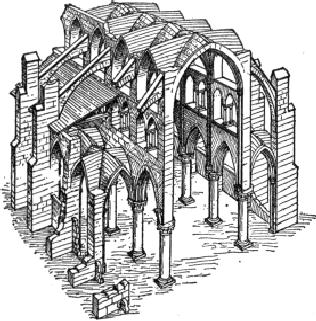
FIG.
105.--CONSTRUCTIVE SYSTEM OF GOTHIC
CHURCH,
ILLUSTRATING
PRINCIPLES OF ISOLATED SUPPORTS AND
BUTTRESSING.
Under
these influences ecclesiastical
architecture advanced with rapid
strides. No
longer
hampered by monastic restrictions, it
called into its service the laity,
whose
guilds
of masons and builders carried from
one diocese to another their
constantly
increasing
stores of constructive knowledge. By a
wise division of labor, each
man
wrought
only such parts as he was
specially trained to undertake. The
master-
builder--bishop,
abbot, or mason--seems to have
planned only the general
arrangement
and scheme of the building, leaving the
precise form of each detail to
be
determined
as the work advanced, according to the
skill and fancy of the artisan
to
whom
it was intrusted. Thus was
produced that remarkable variety in unity
of the
Gothic
cathedrals; thus, also, those
singular irregularities and makeshifts,
those
discrepancies
and alterations in the design, which are
found in every great work of
mediæval
architecture. Gothic architecture
was constantly changing,
attacking new
problems
or devising new solutions of old ones. In
this character of constant flux
and
development
it contrasts strongly with the classic
styles, in which the scheme and
the
principles were easily fixed
and remained substantially unchanged for
centuries.
STRUCTURAL
PRINCIPLES. The
pointed arch, so commonly
regarded as the most
characteristic
feature of the Gothic styles,
was merely an incidental
feature of their
development.
What really distinguished them most
strikingly was the
systematic
application
of two principles which the Roman and
Byzantine builders had
recognized
and applied, but which seem to have
been afterward forgotten until
they
were
revived by the later Romanesque
architects. The first of these
was the
concentration
of strains upon
isolated points of support,
made possible by the
substitution
of groined for barrel vaults.
This led to a corresponding
concentration of
the
masses of masonry at these
points; the building was
constructed as if upon legs
(Fig.
105). The wall became a mere filling-in
between the piers or buttresses, and
in
time
was, indeed, practically
suppressed, immense windows filled with
stained glass

taking
its place. This is well
illustrated in the Sainte
Chapelle at
Paris, built 1242
47
(Figs. 106, 122).
In this remarkable edifice, a series of
groined vaults spring
from
slender
shafts built against deep
buttresses which receive and resist all
the thrusts.
The
wall-spaces between them are wholly
occupied by superb windows filled
with
stone
tracery and stained glass. It would be
impossible to combine the materials
used
more
scientifically or effectively. The
cathedrals of Gerona (Spain) and of
Alby
(France;
Fig.
123)
illustrate the same principle, though in
them the buttresses are
internal
and serve to separate the flanking
chapels.
FIG.
106.--PLAN OF SAINTE CHAPELLE,
PARIS, SHOWING SUPPRESSION OF
SIDE-WALLS.
The
second distinctive principle of
Gothic architecture was that of
balanced
thrusts.
In
Roman buildings the thrust of the
vaulting was resisted wholly by the
inertia of
mass
in the abutments. In Gothic architecture
thrusts were as far as possible
resisted
by
counter-thrusts, and the final resultant
pressure was transmitted by flying
half-
arches
across the intervening portions of the
structure to external buttresses
placed
at
convenient points. This
combination of flying half-arches and
buttresses is called
the
flying-buttress
(Fig.
107). It reached its highest
development in the thirteenth and
fourteenth
centuries in the cathedrals of central
and northern France.
RIBBED
VAULTING. These
two principles formed the structural
basis of the Gothic
styles.
Their application led to the
introduction of two other elements,
second only to
them
in importance, ribbed
vaulting and the
pointed
arch.
The
first of these resulted from the
effort to overcome certain
practical difficulties
encountered
in the building of large groined
vaults. As ordinarily
constructed,
a
groined vault like that in Fig.
47,
must be built as one structure, upon
wooden
centrings
supporting its whole
extent.
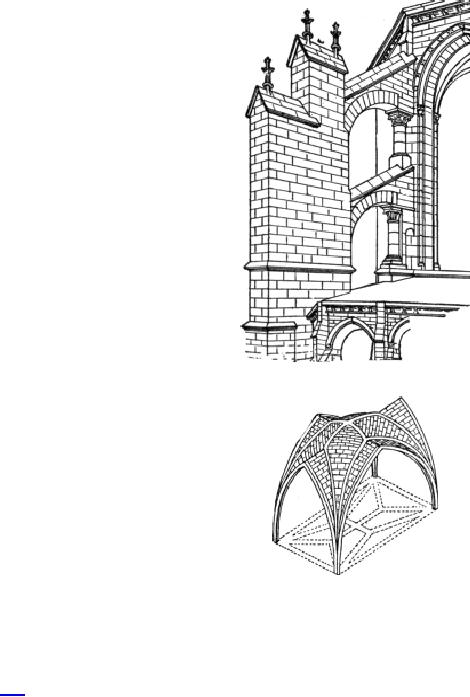
FIG.
107.--EARLY GOTHIC FLYING
BUTTRESS.
FIG.
108.--RIBBED VAULT, ENGLISH TYPE, WITH
DIVIDED GROIN-RIBS AND
RIDGE-RIBS.
The
Romanesque architects conceived the
idea of constructing an
independent
skeleton
of ribs. Two of these were built
against the wall (wall-ribs), two
across the
nave
(transverse ribs); and two others
were made to coincide with the
groins (Figs.
98,
108). The groin-ribs,
intersecting at the centre of the vault,
divided each bay into
four
triangular portions, or compartments,
each of which was really an
independent
vault
which could be separately constructed
upon light centrings supported by
the
groin-ribs
themselves. This principle, though
identical in essence with the
Roman
system
of brick skeleton-ribs for concrete
vaults, was, in application and
detail,
superior
to it, both from the scientific and artistic point of
view. The ribs, richly
moulded,
became, in the hands of the Gothic
architects, important
decorative
features.
In practice the builder gave to
each set of ribs
independently the curvature
he
desired. The vaulting-surfaces were then
easily twisted or warped so as to fit
the
various
ribs, which, being already in
place, served as guides for their
construction.

FIG.
109.--PENETRATIONS AND INTERSECTIONS OF
VAULTS.
a,
a, Penetrations by small semi-circular
vaults sprung from same
level. b, Intersection by
small
semi-circular vault sprung
from higher level; groins
form wavy lines. c,
Intersection
by
narrow pointed vault sprung
from same level; groins
are plane curves.
THE
POINTED ARCH was
adopted to remedy the difficulties
encountered in the
construction
of oblong vaults. It is obvious that
where a narrow semi-cylindrical
vault
intersects
a wide one, it produces
either what are called
penetrations, as at
a
(Fig.
109),
or intersections like that at b, both of
which are awkward in aspect and
hard
to
construct. If, however, one or both
vaults be given a pointed
section, the narrow
vault
may be made as high as the wide one. It
is then possible, with but little
warping
of the vaulting surfaces, to make them
intersect in groins c, which
are
vertical
plane curves instead of wavy
loops like a
and
b.
FIG.
110.--PLATE TRACERY,
CHARLTON-ON-OXMORE.
The
Gothic architects availed
themselves to the full of these two
devices. They built
their
groin-ribs of semi-circular or pointed
form, but the wall-ribs and the
transverse
ribs
were, without exception, pointed
arches of such curvature as would
bring the
apex
of each nearly or quite to the
level of the groin intersection. The
pointed arch,
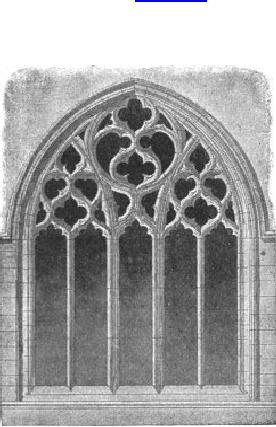
thus
introduced as the most convenient form
for the vaulting-ribs, was soon
applied
to
other parts of the structure.
This was a necessity with the windows and
pier-
arches,
which would not otherwise fit well the wall-spaces
under the wall-ribs of the
nave
and aisle vaulting.
TRACERY
AND GLASS. With the
growth in the size of the windows and the
progressive
suppression of the lateral walls of
vaulted structures, stained
glass came
more
and more generally into use. Its
introduction not only resulted in a
notable
heightening
and enriching of the colors and scheme of
the interior decoration, but
reacted
on the architecture, intensifying the very
causes which led to its
introduction.
It
stimulated the increase in the size of
windows, and the suppression of the
walls,
and
contributed greatly to the development of
tracery.
This latter feature was
an
absolute
necessity for the support of the glass.
Its evolution can be traced
(Figs, 110,
111,
112) from the simple coupling of twin windows under a
single hood-mould, or
discharging
arch, to the florid net-work of the
fifteenth century. In its earlier
forms it
consisted
merely of decorative openings,
circles, and quatrefoils, pierced
through
slabs
of stone (plate-tracery),
filling the window-heads over
coupled windows.
Later
attention
was bestowed upon the form of the
stonework, which was made
lighter and
richly
moulded (bar-tracery),
rather than upon that of the openings
(Fig. 111). Then
the
circular and geometric patterns
employed were abandoned for
more flowing and
capricious
designs (Flamboyant
tracery,
Fig. 112) or (in England) for more
rigid and
rectangular
arrangements (Perpendicular, Fig.
134).
It will be shown later that the
periods
and styles of Gothic architecture
are more easily identified
by the tracery
than
by any other feature.
FIG.
111.--BAR TRACERY, ST. MICHAEL'S,
WARFIELD.
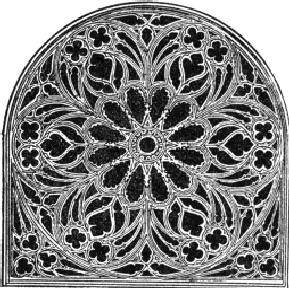
CHURCH
PLANS. The
original basilica-plan underwent
radical modifications
during
the
12th-15th centuries. These resulted in
part from the changes in
construction
which
have been described, and in part from
altered ecclesiastical conditions
and
requirements.
Gothic church architecture was
based on cathedral design; and
the
requirements
of the cathedral differed in many
respects from those of the
monastic
churches
of the preceding period.
The
most important alterations in the plan
were in the choir and transepts. The
choir
was
greatly lengthened, the transepts
often shortened. The choir
was provided with
two
and often four side-aisles, and one or
both of these was commonly
carried
entirely
around the apsidal termination of the
choir, forming a single or
double
ambulatory.
This combination of choir,
apse, and ambulatory was
called, in French
churches,
the chevet.
Another
advance upon Romanesque models
was the multiplication of
chapels--
a
natural consequence of the more popular
character of the cathedral as
compared
with
the abbey. Frequently lateral
chapels were built at each
bay of the side-aisles,
filling
up the space between the deep
buttresses, flanking the nave as well as
the
choir.
They were also carried
around the chevet
in
most of the French
cathedrals
(Paris,
Bourges, Reims, Amiens,
Beauvais, and many others); in many of
those in
Germany
(Magdeburg, Cologne, Frauenkirche at
Treves), Spain (Toledo,
Leon,
Barcelona,
Segovia, etc.), and Belgium (Tournay,
Antwerp). In England the choir
had
more
commonly a square eastward
termination. Secondary transepts
occur
frequently,
and these peculiarities, together with
the narrowness and great length
of
most
of the plans, make of the English
cathedrals a class by
themselves.
FIG.
112.--ROSE WINDOW, CHURCH OF
ST. OUEN, ROUEN.
PROPORTIONS
AND COMPOSITION. Along
with these modifications of the
basilican
plan should be noticed a great
increase in the height and slenderness of
all
parts
of the structure. The lofty clearstory, the
arcaded triforium-passage or
gallery
beneath
it, the high pointed pier-arches, the
multiplication of slender
clustered
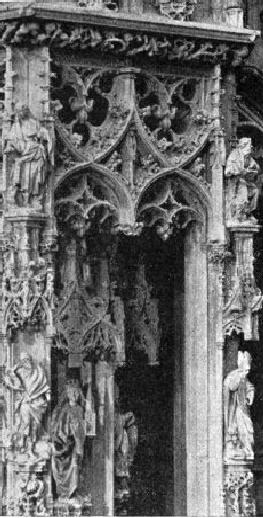
shafts,
and the reduction in the area of the
piers, gave to the Gothic
churches an
interior
aspect wholly different from that of the
simpler, lower, and more
massive
Romanesque
edifices. The perspective effects of the
plans thus modified, especially
of
the
complex choir and chevet
with their
lateral and radial chapels,
were remarkably
enriched
and varied.
The
exterior was even more
radically transformed by these
changes, and by the
addition
of towers and spires to the fronts, and
sometimes to the transepts and to
their
intersection with the nave. The deep
buttresses, terminating in pinnacles,
the
rich
traceries of the great lateral
windows, the triple portals
profusely sculptured,
rose-windows
of great size under the front and
transept gables, combined to
produce
effects
of marvellously varied light and shadow,
and of complex and elaborate
structural
beauty, totally unlike the broad
simplicity of the Romanesque
exteriors.
FIG.
113.--FLAMBOYANT DETAIL FROM PULPIT IN
STRASBURG CATHEDRAL.
DECORATIVE
DETAIL. The
mediæval designers aimed to
enrich every
constructive
feature
with the most effective play of lights
and shades, and to embody in the
decorative
detail the greatest possible amount of
allegory and symbolism, and
sometimes
of humor besides. The deep jambs and
soffits of doors and
pier-arches
were
moulded with a rich succession of hollow and
convex members, and
adorned
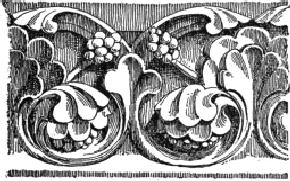
with
carvings of saints, apostles,
martyrs, and angels. Virtues and
vices, allegories of
reward
and punishment, and an extraordinary world of
monstrous and grotesque
beasts,
devils, and goblins filled the
capitals and door-arches, peeped
over tower-
parapets,
or leered and grinned from gargoyles and
corbels. Another source
of
decorative
detail was the application of
tracery like that of the windows to
wall-
panelling,
to balustrades, to open-work gables, to
spires, to choir-screens, and
other
features,
especially in the late fourteenth and
fifteenth centuries (cathedrals of
York,
Rouen,
Cologne; Henry VII.'s Chapel,
Westminster). And finally in the carving
of
capitals
and the ornamentation of mouldings the
artists of the thirteenth century
and
their
successors abandoned completely the
classic models and traditions which
still
survived
in the early twelfth century. The later
monastic builders began to
look
directly
to nature for suggestions of decorative
form. The lay builders who
sculptured
the
capitals and crockets and finials of the
early Gothic cathedrals
adopted and
followed
to its finality this principle of
recourse to nature, especially to plant
life. At
first
the budding shoots of early
spring were freely imitated
or skilfully
conventionalized,
as being by their thick and vigorous
forms the best adapted
for
translation
into stone (Fig. 114). During the
thirteenth century the more
advanced
stages
of plant growth, and leaves more complex
and detailed, furnished the
models
for
the carver, who displayed his
skill in a closer and more
literal imitation of their
minute
veinings and indentations (Fig.
115).
FIG.
114.--EARLY GOTHIC
CARVING.
This
artistic adaptation of natural
forms to architectural decoration
degenerated later
into
a minutely realistic copying of natural
foliage, in which cleverness of
execution
took
the place of original invention. The
spirit of display is characteristic of
all late
Gothic
work. Slenderness, minuteness of detail,
extreme complexity and intricacy
of
design,
an unrestrained profusion of decoration
covering every surface, a
lack of
largeness
and vigor in the conceptions, are
conspicuous traits of Gothic
design in the
fifteenth
century, alike in France, England,
Germany, Spain, and the Low
Countries.
Having
worked out to their conclusion the
structural principles bequeathed to
them
by
the preceding centuries, the authors of
these later works seemed to
have devoted
themselves
to the elaboration of mere decorative
detail, and in technical
finish
surpassed
all that had gone before (Fig.
113).
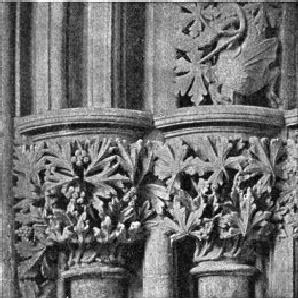
FIG.
115.--CARVING, DECORATED PERIOD,
FROM SOUTHWELL
MINSTER.
CHARACTERISTICS
SUMMARIZED. In the light
of the preceding explanations
Gothic
architecture may be defined as that
system of structural design
and
decoration
which grew up out of the effort to
combine, in one harmonious
and
organic
conception, the basilican plan with a
complete and systematic construction
of
groined
vaulting. Its development was
controlled throughout by considerations
of
stability
and structural propriety, but in the
application of these considerations
the
artistic
spirit was allowed full
scope for its exercise.
Refinement, good taste,
and
great
fertility of imagination characterize the
details and ornaments of
Gothic
structures.
While the Greeks in harmonizing the
requirements of utility and beauty
in
architecture
approached the problem from the æsthetic
side, the Gothic
architects
did
the same from the structural side.
Their admirably reasoned
structures express as
perfectly
the idea of vastness, mystery, and
complexity as do the Greek temples
that
of
simplicity and monumental
repose.
The
excellence of Gothic architecture lay not
so much in its individual details as
in
its
perfect adaptation to the purposes for
which it was developed--its triumphs
were
achieved
in the building of cathedrals and large
churches. In the domain of civil
and
domestic
architecture it produced nothing
comparable with its ecclesiastical
edifices,
because
it was the requirements of the cathedral
and not of the palace, town-hall,
or
dwelling,
that gave it its form and
character.
PERIODS.
The
history of Gothic architecture is
commonly divided into three
periods,
which
are most readily
distinguished by the character of the
window-tracery. These
periods
were not by any means synchronous in the
different countries; but the
order
of
sequence was everywhere the
same. They are here given,
with a summary of the
characteristics
of each.
EARLY POINTED PERIOD.
[Early
French;
Early
English or
Lancet
Period
in England;
Early
German,
etc.] Simple groined vaults;
general simplicity and vigor of
design and
detail;
conventionalized foliage of small
plants; plate tracery, and narrow
windows
coupled
under pointed arch with circular
foiled openings in the window-head.
(In
France,
1160 to 1275.)
MIDDLE POINTED PERIOD.
[Rayonnant
in
France; Decorated
or
Geometric
in
England.]
Vaults
more perfect; in England
multiple ribs and liernes;
greater slenderness and
loftiness
of proportions; decoration much richer,
less vigorous; more
naturalistic
carving
of mature foliage; walls
nearly suppressed, windows of great
size, bar tracery
with
slender moulded or columnar
mullions and geometric combinations
(circles and
cusps)
in window-heads, circular (rose)
windows. (In France, 1275 to
1375.)
FLORID GOTHIC PERIOD.
[Flamboyant
in
France; Perpendicular
in
England.] Vaults of
varied
and richly decorated design; fan-vaulting
and pendants in England,
vault-ribs
curved
into fanciful patterns in Germany and
Spain; profuse and minute
decoration
and
cleverness of technical execution
substituted for dignity of design; highly
realistic
carving
and sculpture, flowing or flamboyant
tracery in France; perpendicular
bars
with
horizontal transoms and four-centred
arches in England; "branch-tracery"
in
Germany.
(In France, 1375 to 1525.)
Table of Contents:
- PRIMITIVE AND PREHISTORIC ARCHITECTURE:EARLY BEGINNINGS
- EGYPTIAN ARCHITECTURE:LAND AND PEOPLE, THE MIDDLE EMPIRE
- EGYPTIAN ARCHITECTURE—Continued:TEMPLES, CAPITALS
- CHALDÆAN AND ASSYRIAN ARCHITECTURE:ORNAMENT, MONUMENTS
- PERSIAN, LYCIAN AND JEWISH ARCHITECTURE:Jehovah
- GREEK ARCHITECTURE:GENERAL CONSIDERATIONS, THE DORIC
- GREEK ARCHITECTURE—Continued:ARCHAIC PERIOD, THE TRANSITION
- ROMAN ARCHITECTURE:LAND AND PEOPLE, GREEK INFLUENCE
- ROMAN ARCHITECTURE—Continued:IMPERIAL ARCHITECTURE
- EARLY CHRISTIAN ARCHITECTURE:INTRODUCTORY, RAVENNA
- BYZANTINE ARCHITECTURE:DOMES, DECORATION, CARVED DETAILS
- SASSANIAN AND MOHAMMEDAN ARCHITECTURE:ARABIC ARCHITECTURE
- EARLY MEDIÆVAL ARCHITECTURE:LOMBARD STYLE, FLORENCE
- EARLY MEDIÆVAL ARCHITECTURE.—Continued:EARLY CHURCHES, GREAT BRITAIN
- GOTHIC ARCHITECTURE:STRUCTURAL PRINCIPLES, RIBBED VAULTING
- GOTHIC ARCHITECTURE IN FRANCE:STRUCTURAL DEVELOPMENT
- GOTHIC ARCHITECTURE IN GREAT BRITAIN:GENERAL CHARACTER
- GOTHIC ARCHITECTURE IN GERMANY, THE NETHERLANDS, AND SPAIN
- GOTHIC ARCHITECTURE IN ITALY:CLIMATE AND TRADITION, EARLY BUILDINGS.
- EARLY RENAISSANCE ARCHITECTURE IN ITALY:THE CLASSIC REVIVAL, PERIODS
- RENAISSANCE ARCHITECTURE IN ITALY—Continued:BRAMANTE’S WORKS
- RENAISSANCE ARCHITECTURE IN FRANCE:THE TRANSITION, CHURCHES
- RENAISSANCE ARCHITECTURE IN GREAT BRITAIN AND THE NETHERLANDS
- RENAISSANCE ARCHITECTURE IN GERMANY, SPAIN, AND PORTUGAL
- THE CLASSIC REVIVALS IN EUROPE:THE EIGHTEENTH CENTURY
- RECENT ARCHITECTURE IN EUROPE:MODERN CONDITIONS, FRANCE
- ARCHITECTURE IN THE UNITED STATES:GENERAL REMARKS, DWELLINGS
- ORIENTAL ARCHITECTURE:INTRODUCTORY NOTE, CHINESE ARCHITECTURE
- APPENDIX.